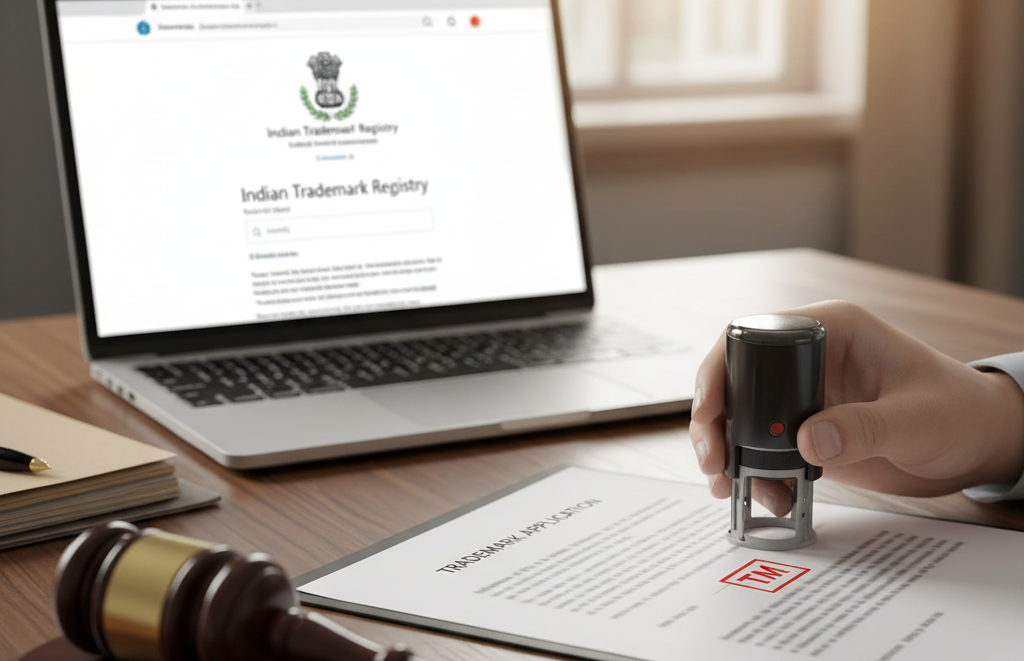Trademark, the silent ambassador of a brand, that carries trust, reputation and the promise of quality. It does not stand merely as a decorative emblem but protects the brand, shields its identity and prevents unfair competition. In an age where imitation flies faster than innovation, Trademark protection becomes the bulletproof vest relied on by companies globally.
Every great brand deserves its armor and here’s how to outfit yours with a registered trademark:
Step- 1: Search- Decide which class of goods and services your trademark can be registered, to determine the scope of legal protection of the brand. Classes 1-34 are for goods and 35-45 for services. Then conduct a search in Controller General of Patents, Designs and Trademarks website under the respective classes to check for similarly registered trademarks.
Step- 2: Filing- A trademark application is to be filed via Form TM-A. A single application can be filed for multiple classes or series of trademark or collective trademark before the Registrar of Trademarks. Official fees levied by the government for Individuals, startups, and small enterprise (MSME) for E-filing is Rs. 4,500/- and physical filing is Rs. 5000/- While for all other entities E-filing is Rs. 9000/- and physical filing is Rs. 10000/-. On receiving the Application, the Trade Mark registry will issue a provisional number and till registration we can use TM mark beside one’s brand name.
Step-3: Examination- The Trademark Registry will then examine the registrability of the application by reviewing it for compliance with relevant laws and regulations. If any issues are found, an examination report is issued, requiring the applicant to respond within a specified timeframe to avoid abandonment of the application. We must respond to the report addressing each objection with substantive reasoning and evidence to shown the marks uniqueness and distinctiveness.
Step- 4: Publication- In the event of acceptance of the application by the Registrar, the brand name is published in the Indian Trademark Journal.
Step-5: Opposition- A notice of opposition to the Trademark Registry may be filed by any interested party within 4 months from the date of last publication and the applicant has to reply to the opposition notice by filing a counter statement within 2 months of the receipt of the opposition notice. If the application is opposed, then the Trademark Registry will request both parties to furnish evidence in writing. If the dispute is not settled by the parties, then the matter is determined at a hearing. Registration of an opposed Trademark application will be delayed pending till the determination of the opposition.
Step- 6: Registration- In the absence of opposition, the Trademark is registered, and a Registration Certificate is issued for 10 years from the date of filing of the application.
Documents Required:
- Form TM-A
- Full Name, Address, Mobile No., email ID, Nationality and Nature of the Business of the Applicant. (If the Application is to be filed in the name of a company or a firm other than the individual, then the name and the address of the company/firm, and the name and respective details of the Director/Partner/Proprietor.
- Date of first use of the mark in India, if any or whether it is proposed to be used.
- If the trademark is already in use, you have to execute a User Affidavit
- Power of Attorney signed by the Applicant.
Legal Precedents wrt TM:
- In Pernod Ricard India Pvt. Ltd. v. Karanveer Singh Chhabra (Supreme Court, 2025), the Court declined to grant an injunction against the sale of “London Pride” whisky, holding that it was not deceptively similar to Pernod Ricard’s “Blenders Pride.” The Court emphasized that the word “Pride” is generic and cannot be monopolised, and that the dominant elements— “Blenders” versus “London”—along with differences in packaging, label design, and trade dress, create a distinct overall impression. Considering that consumers of premium and ultra-premium whisky are more discerning, the Court concluded that there was no real likelihood of confusion, and directed the trial court to decide the case on its merits.
- In Ferrero S.p.A. & Ors. v. M.B. Enterprises (Delhi High Court, 28 July 2025), Justice Saurabh Banerjee recognized Ferrero’s brands, including Nutella and the trade dress of its chocolates, as well-known trademarks under the Trade Marks Act, 1999. The Court, proceeding ex parte, found that M.B. Enterprises was selling counterfeit products with identical marks and packaging, and granted a permanent injunction, ordered delivery-up of infringing stock, and awarded ₹30 lakh in damages plus costs. A “well-known trademark,” the Court explained, is one widely recognized by the public, whose reputation and goodwill are such that use on unrelated goods is likely to suggest a connection with the original brand.
- In Aditya Birla Fashion & Retail Ltd. v. Friends Inc & Anr. (Delhi High Court, 9 Jan 2025), the Court declared “PETER ENGLAND” a well-known trademark under the Trade Marks Act, 1999. Finding that the defendants had unlawfully used the mark on signage and business materials, the Court granted a permanent injunction, directed removal of infringing material, and noted the defendants’ compliance. The ruling underscores strong protection for reputed marks based on their long-standing use, market reputation, and goodwill.
- In Christian Louboutin SAS v. Abubaker & Ors. (Delhi High Court, 2018), the Court rejected Louboutin’s claim to exclusive rights over the iconic red sole of its shoes, holding that a single colour, by itself, cannot qualify as a trademark under the Trade Marks Act, 1999. Even though the shade of red had global recognition and Indian registrations, the Court ruled that statutory protection applies only to combinations of colours or colours used with other distinctive elements, not to one hue standing alone. This decision clarified the limits of colour marks in India and signalled that brand reputation alone is insufficient to claim monopoly over a solitary colour.
- In H-D U.S.A., LLC v. Vijaypal Dhayal, Owner/Proprietor of Red Rose Industries, the Delhi High Court granted Harley-Davidson a permanent injunction against Red Rose Industries for infringing its iconic "Eagle" logo on footwear. The Court found the defendant's logo to be structurally and visually similar to Harley-Davidson's, leading to a likelihood of consumer confusion. The defendant was also ordered to pay ₹5 lakh in damages and costs. This case underscores the judiciary's commitment to protecting well-known trademarks and preventing unfair commercial advantage through deceptive practices.
Ideas are valuable, but a trademark keeps it safe. Here’s why registration matters:
Registration of a trademark transforms your brand into a legally recognized identity. It dons a protective blanket over the very soul of a business. While it is not compulsory to register your trademark in India, a registered trademark under the Trade Marks Act, 1999 provides the owner with exclusive statutory rights preventing the competitors from identity theft of the brand and ensures its voice in the marketplace remains unmistakably its own.
Not only is the originality of the product sustained, but a registered trademark becomes synonymous with consumer loyalty, trust and heritage. It is the most effective weapon against counterfeiting and enables the owner to pursue legal remedies if your intellectual property is infringed.
Sep 22, 2025



Leave a Comment